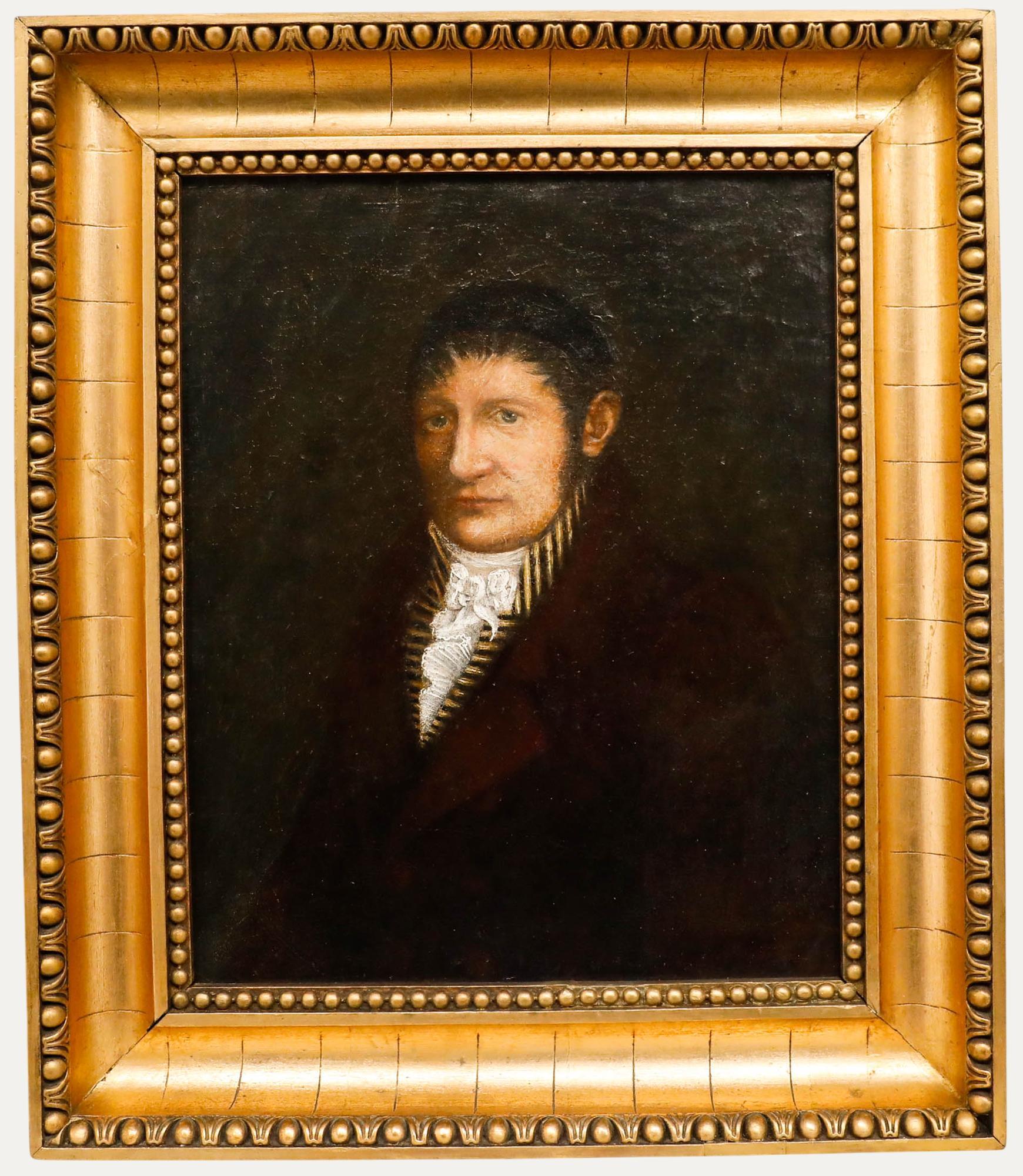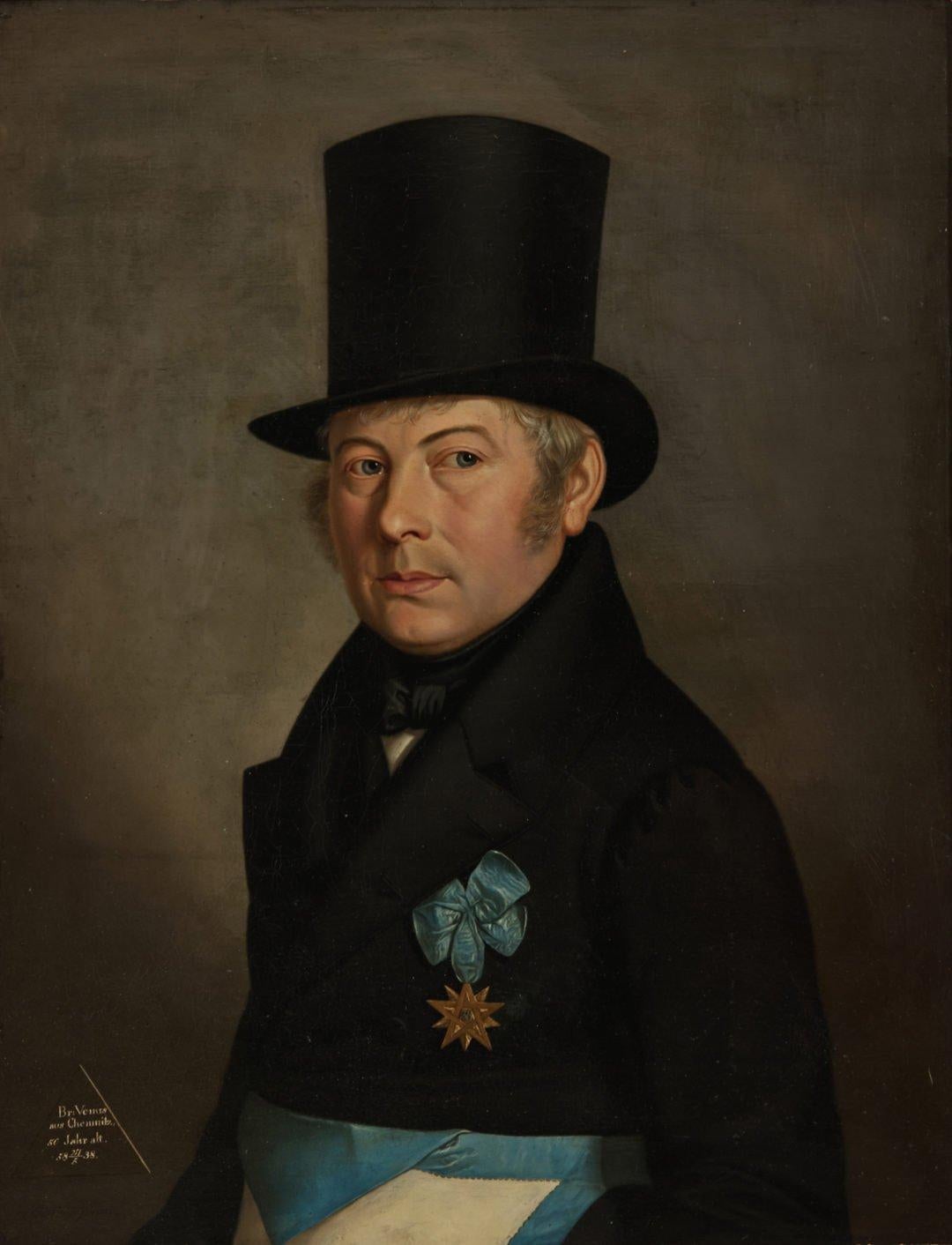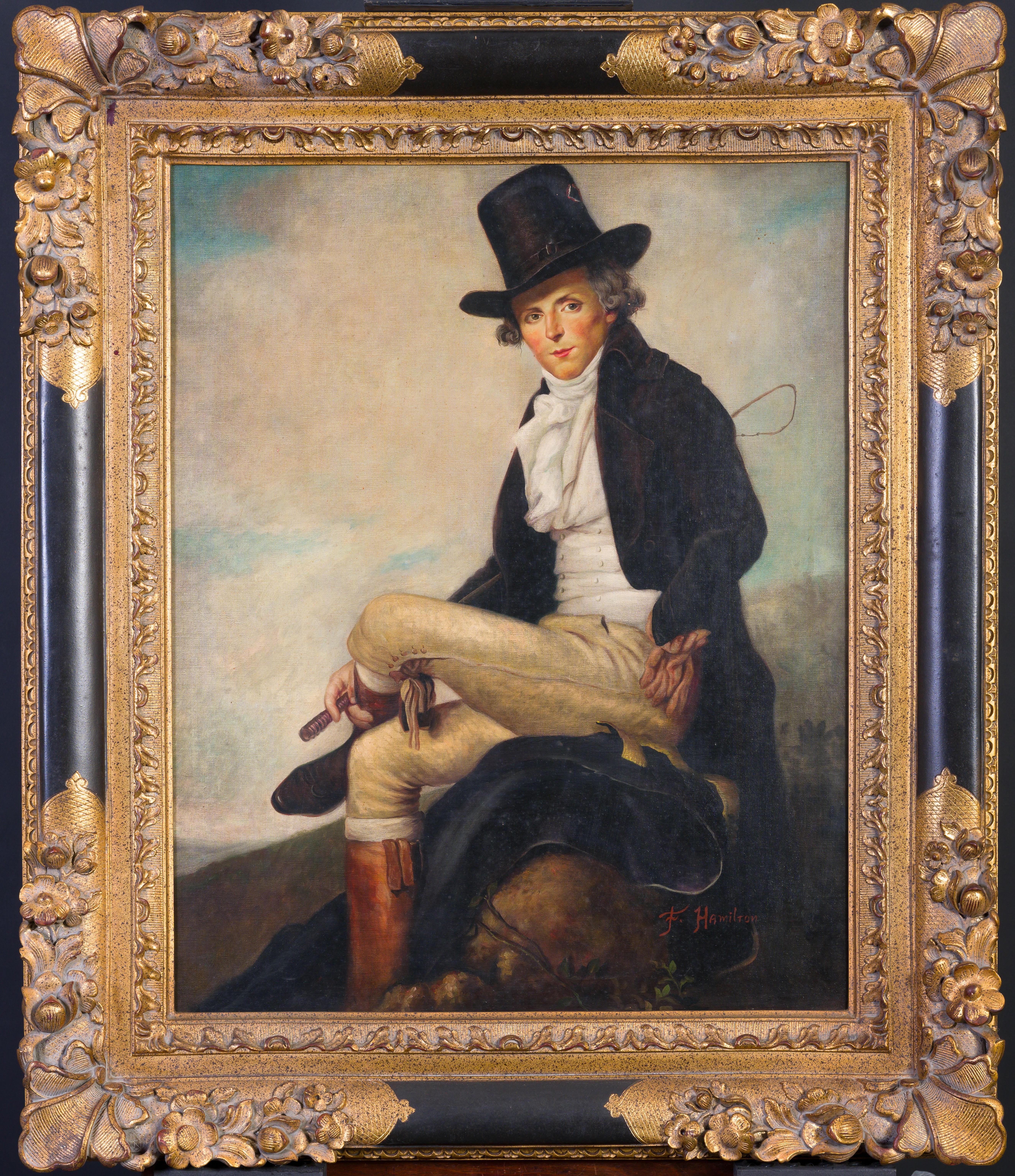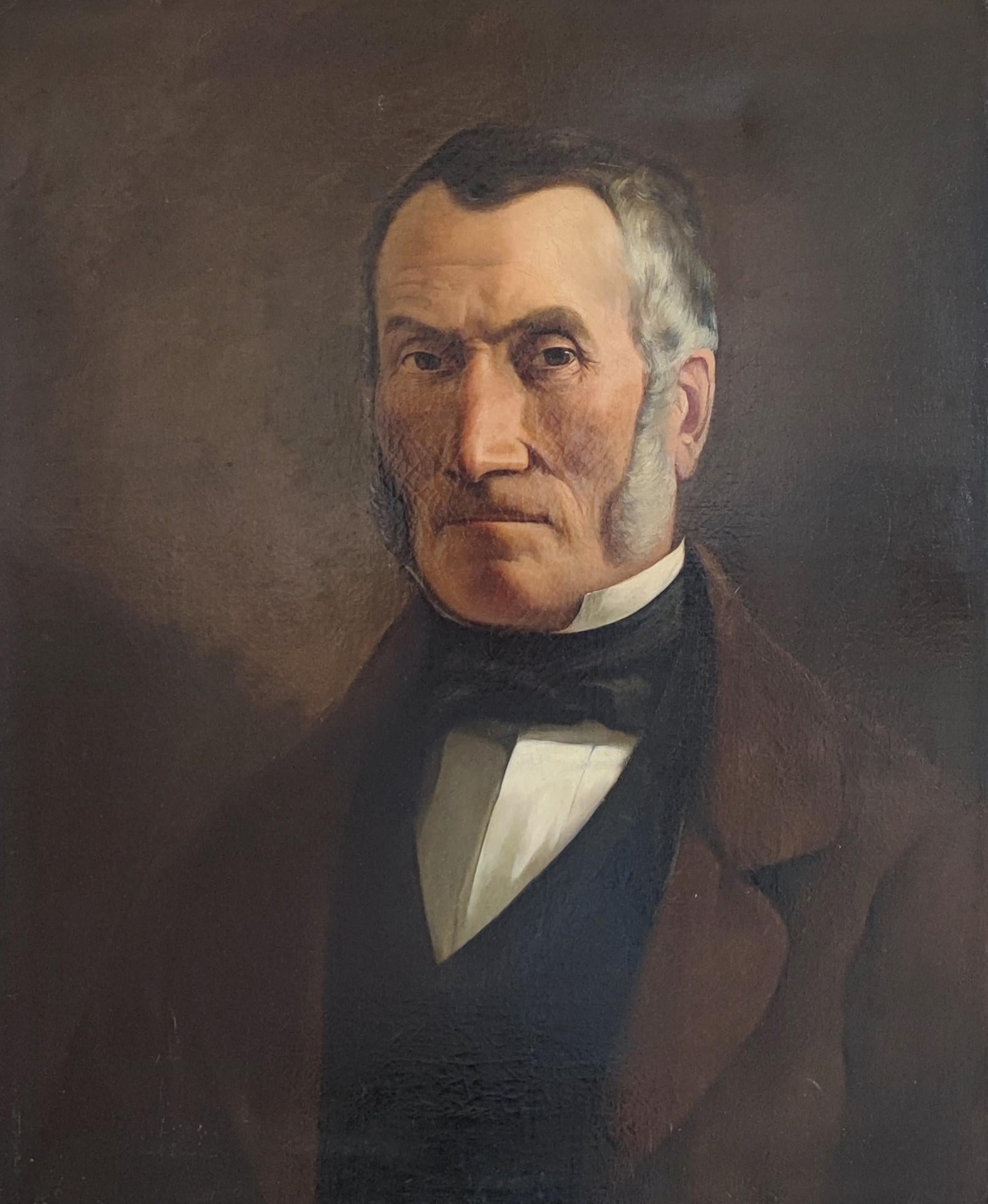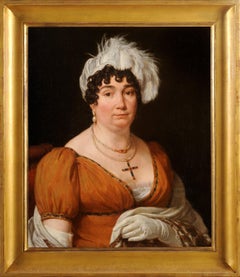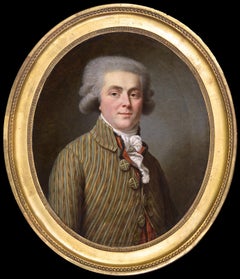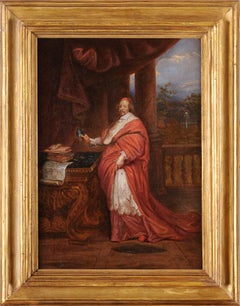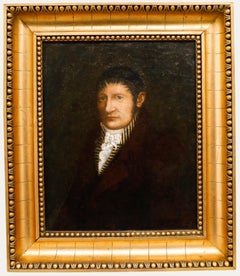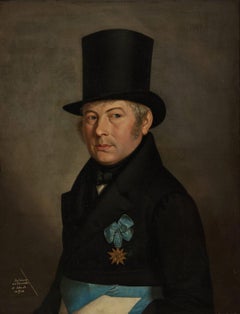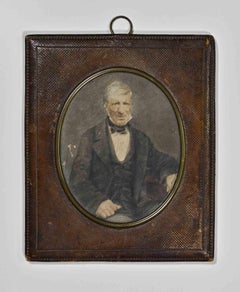Items Similar to Men portrait with a hat
Want more images or videos?
Request additional images or videos from the seller
1 of 9
Men portrait with a hatCirca 1810
Circa 1810
$38,926.41
£28,883.59
€32,500
CA$54,366.57
A$58,961.83
CHF 30,968.99
MX$716,191.38
NOK 387,527.94
SEK 364,879.20
DKK 247,593.16
About the Item
Henry William Pickersgill, attributed to
(London 1782 – London 1875)
Portrait of Captain Samuel Wright
Oil on canvas
H. 92 cm; L. 73 cm
Circa 1810/1815
Provenance:
– Brother of the sitter, John Wright (1758-1840), Lenton Hall, Nottinghamshire
– His son Francis Beresford Wright (1806-1873), Osmaston Manor, Derbyshire
– His son John Wright, known as Osmaston (1831-1901), Hawkhurst Court, Sussex
– His son Francis Plumptre Beresford Osmaston (1857-1925), barrister, Stoneshill, Limpsfield, Surrey
– His daughter Eleanor Dorothea Osmaston (1887-1959), feminist politician married to economist and newspaper tycoon Walter Layton (1884-1966), Beacon Crag, Porthleven, Cornwall
– Sold by Lady Layton in the 1950s to the Arthur Ackerman & Son gallery, New York
– Salem Collection Academy and College, Winston-Salem, North Carolina
A Nottingham native, Samuel Wright (1754-1839) was the son of banker John Wright (1723-1789) and his wife Ann (1721-1792), née Sherbrooke. John Wright ran the bank founded in Nottingham in 1761 by his father, Ichabod Wright (1700-1777), but the family was originally a merchant family, very influential in Nottinghamshire and Derbyshire.
Unlike his brother John (1758-1840), who took over the family bank in 1789, Samuel pursued a military career, becoming a captain in the 15th Hussars (Light Dragoons). He was also Lieutenant-Colonel of the Bunny Volunteers, a kind of local militia formed in 1798.
Meanwhile, on July 15, 1788, he had married Anne Margaret of Coventry, daughter of George William, 6th Earl of Coventry (1722-1809), who was portrayed by Perronneau in 1773. Anne Margaret, born in 1757 in the Oxford area, had divorced Edward Foley (married in 1778) in 1787, which caused a stir in both Houses of Parliament at the time.
The couple lived in Gunthorpe (a few kilometers east of Nottingham), specifically at Gunthorpe Lodge, until Anne Margaret's death in 1822; Samuel was still living in Gunthorpe in 1824, before retiring to Upper Broughton, formerly Broughton Sunley, where he is buried. In 1825, according to Broughton parish records, he married Anne Foulkes (1805-1866) for the second time. Widowed in 1839, she inherited Samuel's estate and remarried in 1846. Samuel therefore had no direct descendants.
In all likelihood, Samuel Wright bequeathed his portrait upon his death to his brother John, who was only able to enjoy it for a year at his home, Lenton Hall in Nottingham, which he had built in 1802. Around 1845, the painting was placed at Osmaston Manor, the house that John's son Francis had built at that time. It remained in his family until the 1950s.
This portrait shows him in the prime of life, around 55 or 60 years old, in sportsman's attire, with his riding habit, top hat, and hunting whip.
Henry-William Pickersgill was one of the leading English portrait painters of the first half of the 19th century; from 1845 until his death, he was virtually unrivaled in painting the celebrities of the time. His portraits are characterized by simplicity and precision.
He entered the Royal Academy in London in 1805, where he exhibited his first portrait the following year.
- Attributed to:Henry-William Pickersgill (1782 - 1875, English)
- Creation Year:Circa 1810
- Dimensions:Height: 36.23 in (92 cm)Width: 28.75 in (73 cm)
- Medium:
- Movement & Style:
- Period:
- Condition:
- Gallery Location:BELEYMAS, FR
- Reference Number:1stDibs: LU1857216545432
About the Seller
3.0
Vetted Professional Seller
Every seller passes strict standards for authenticity and reliability
Established in 2017
1stDibs seller since 2022
5 sales on 1stDibs
- ShippingRetrieving quote...Shipping from: BELEYMAS, France
- Return Policy
Authenticity Guarantee
In the unlikely event there’s an issue with an item’s authenticity, contact us within 1 year for a full refund. DetailsMoney-Back Guarantee
If your item is not as described, is damaged in transit, or does not arrive, contact us within 7 days for a full refund. Details24-Hour Cancellation
You have a 24-hour grace period in which to reconsider your purchase, with no questions asked.Vetted Professional Sellers
Our world-class sellers must adhere to strict standards for service and quality, maintaining the integrity of our listings.Price-Match Guarantee
If you find that a seller listed the same item for a lower price elsewhere, we’ll match it.Trusted Global Delivery
Our best-in-class carrier network provides specialized shipping options worldwide, including custom delivery.More From This Seller
View AllPortrait of Madame Leblond
Located in BELEYMAS, FR
French school circa 1815
Portrait of Madame Leblond
Oil on canvas
H. 66 cm; W. 55 cm
Named on the back
Comparable to the works of painters such as Louis Hersent, our portrait, unsig...
Category
1810s French School Figurative Paintings
Materials
Canvas, Oil
Portrait of a man during French Revolution
Located in BELEYMAS, FR
Antoine VESTIER, attributed to
(Avallon, 1740 - Paris, 1824)
Portrait of a man under the Revolution
Oil on canvas
H. 46 cm; L. 37 cm
Circa 1793-95
This beautiful unsigned portrait i...
Category
1790s French School Figurative Paintings
Materials
Canvas, Oil
Portrait of baron de Roisin - Gendarmerie general
Located in BELEYMAS, FR
Flemish school of the 19th century
Armorial portrait of Baron Henri de ROISIN (1787-1846)
in the uniform of a general of the gendarmerie (1835)
Oil on canvas
H. 108 cm; W. 90 cm
Bar...
Category
1830s French School Portrait Paintings
Materials
Canvas, Oil
Cardinal Mazarin portrait
Located in BELEYMAS, FR
French School circa 1645
Portrait of Cardinal Mazarin - Sketch
Oil on canvas
H. 41.5 cm; W. 27 cm
Provenance: Collection of the Reverend Georges Downing Bowles (1789-1863)
Would ...
Category
1640s French School Portrait Paintings
Materials
Canvas, Oil
Portrait of a man in armor
Located in BELEYMAS, FR
Attributed to Jacques DUMONT aka DUMONT LE ROMAIN
(Paris 1701 - 1781)
Presumed portrait of Louis-Joseph de Formanoir (?-1732)
Oil on canvas
H. 91.5 cm; L. 73 cm
Signed on the helmet:...
Category
1750s French School Portrait Paintings
Materials
Canvas, Oil
Presumed artist self-portrait
Located in BELEYMAS, FR
Louis-Gabriel BLANCHET
(Versailles, 1701 – Rome, 1772)
Presumed self-portrait of the artist
Oil on canvas
H. 73 cm; W. 60 cm
Circa 1730
Originally presented in a Restoration period frame with a "Mignard" cartouche, this beautiful painting initially appeared to us as a work from northern Italy. However, it exuded a rather French form of refinement, suggesting that its artist may have assimilated a dual influence from both sides of the Alps.
We thank our colleague and friend Philippe Mendès for spontaneously and judiciously "bringing out" the name of Louis-Gabriel Blanchet, a Romanized French portraitist, whose spirit and stylistic characteristics we clearly recognize here.
Blanchet's "French" years, before his final departure for Rome in 1728, following his winning of the second Grand Prix for painting after Subleyras in 1727, are extremely poorly documented. His father, Gabriel, was valet to Blouin, himself Louis XIV's first valet at the time. According to Thierry Lefrançois, Blanchet was one of the few students of Nicolas Bertin (1667-1736), whose studio he is said to have joined in the early 1720s. At a baptism on March 24, 1724, where he was godfather, he is mentioned as a painter in the picture store of the Duke of Antin, the director of buildings between 1708 and 1736. At this time, he was probably already married to Jeanne Quément, with whom he had a daughter also named Jeanne, who would marry Nicolas Aviet, the son of a valet in the queen's wardrobe, in Versailles in 1738.
When Blanchet arrived in Rome in October 1728, he was accompanied by Subleyras, Trémolières, and Slodtz. He enjoyed the goodwill of Vleughels, the director of the Académie de France, which had been based at the Palazzo Mancini since 1725, even though the latter was not always kind to our resident. From 1732, he was under the protection of the Duke of Saint-Aignan when he took up his post as ambassador to Rome. Along with Slodtz and Subleyras, they formed a trio of friends, joined by Joseph Vernet shortly after his arrival in Rome in 1734. Slodtz and Blanchet, on the occasion of Subleyras's marriage in 1739, were there to attest that their friend was not bound by any marital commitment, and Blanchet was a witness at Vernet's wedding in 1745.
It is most likely from these early years in Rome that our portrait of the artist dates, the expression and turn of his face irresistibly reminiscent of a self-portrait. The still relatively youthful features may correspond to Blanchet's thirty-something years, and the fluffy wig was still fashionable at this time.
The painting fits well with the depiction of a young painter wanting to display both the beginnings of success and a certain simplicity or restraint. A slight smile expresses a form of assurance in this man with a gentle, sincere gaze and a face radiating a keen sense of wit. We find here the air of intimacy present in almost all of Blanchet's portraits, even those from the 1750s and 1760s, as well as an almost complicity with the viewer. The spirit of the painting is quite close to that of the presumed portrait of Bouchardon (painted around 1730) and the portrait of Pannini, painted in 1736, but it possesses a more natural quality, notably thanks to the absence of decorum. Our work exhibits the characteristics of Blanchet's paintings: elegance, luminosity (especially in the whites), vibrant and refined colors (here, the harmony of the garnet of the garment and the slate blue of the background, whose uniformity is tempered by a very sketched landscape and a grove of greenery), light complexions, rather rosy cheekbones, often full lips, and rather tight framing.
According to the Academy's rules, Blanchet's stay should have ended in the spring of 1732, but, for reasons unknown, he remained in the Eternal City until his death, as did his friend Subleyras, with whom he shared accommodation until the late 1730s. The latter regularly called upon him to collaborate on his paintings, such as The Meal at Simon's. Through Saint-Aignan's intervention, Blanchet was employed in the late 1730s by the Stuart princely family, then exiled in Italy. He notably produced copies (now lost) after Liotard of the portraits of Charles Edward and Henry Benedict, the sons of James III Stuart. The latter also commissioned three other portraits (now in the National Portrait Gallery in London), whose more formal character contrasts with the intimate spirit of Blanchet's portraits. Blanchet frequented English painters, such as the landscape painter Richard Wilson, and studied with the Scottish portraitist Katherine Read...
Category
1730s French School Portrait Paintings
Materials
Oil, Canvas
You May Also Like
Portrait of a man
By Antoine Jean Gros
Located in Paris, IDF
French school from the beginning of the 19th century
Three-quarter bust portrait of a man
Oil on panel
28 x 21 cm
Circa 1820
This portrait of a man, typical of the French school o...
Category
Early 19th Century French School Portrait Paintings
Materials
Oil
Early 19th Century Oil - Portrait of a Gentleman
Located in Corsham, GB
A formal nineteenth-century portrait of a gentleman wearing a dark crimson coat with an elaborate collar, set against a dark background. Well presented in a gilt-effect frame with be...
Category
Early 19th Century Portrait Paintings
Materials
Oil
19th Century German School, Gentleman with Top Hat, 1839
Located in Beachwood, OH
19th Century German School
Br: Venus aus Chemnitz 50 Jahre alt 58 24/5 39, 1839
Oil on canvas
Signed lower left
25.5 x 20 inches
30.5 x 24.75 inches, framed
The gentleman is Johann ...
Category
1830s Figurative Paintings
Materials
Oil
Portrait of Man - Paint - 19th Century
Located in Roma, IT
Oil on cardboard realized in Italy in 19th Century.
Includes a leather frame.
Good condition except for some losses of color in the mid-right.
Category
19th Century Modern Figurative Paintings
Materials
Oil
$359 Sale Price
25% Off
Portrait of Pierre Seriziat
Located in Douglas, Isle of Man
Copy of a Portrait of Pierre Seriziat by Jacques Louis David which was painted in 1795 , David 1748-1825, this picture is a direct copy by an artist by the name of F. Hamilton. There...
Category
Late 20th Century Portrait Paintings
Materials
Canvas, Oil, C Print
Elegant man
Located in Genève, GE
Work on canvas
Category
19th Century Portrait Paintings
Materials
Oil
$2,347
